For years, countless companies have relied on PPC advertising to drive brand awareness and growth.
However, in today’s world, PPC has become more important than ever, thanks to the rise of generative AI and the transformation of search engines.
In this PPC guide, you’ll learn how PPC marketing works and how to create effective PPC campaigns.
The guide was prepared by our team of PPC experts who have extensive experience working with PPC platforms and running campaigns for clients in various niches.
The Beginners Guide to PPC Marketing
What is PPC Marketing?
PPC, or “Pay-Per-Click” advertising, is one of the most popular forms of SEM (Search Engine Marketing) and a core part of digital marketing.
PPC is a form of paid advertising, which means you pay a fee every time someone clicks on your ads.
Most people associate PPC with Google Ads or Bing Ads. However, PPC doesn’t just provide companies with a way to stand out on the SERPs.
PPC is also the primary advertising model for various shopping engines and social media platforms. You can run paid campaigns on channels like Facebook, Instagram, and even Amazon.
Why is PPC Marketing Important?
PPC marketing provides companies with a quick, affordable, and efficient way to capture customers’ attention.
Compared to other advertising methods, PPC can deliver numerous unique benefits.
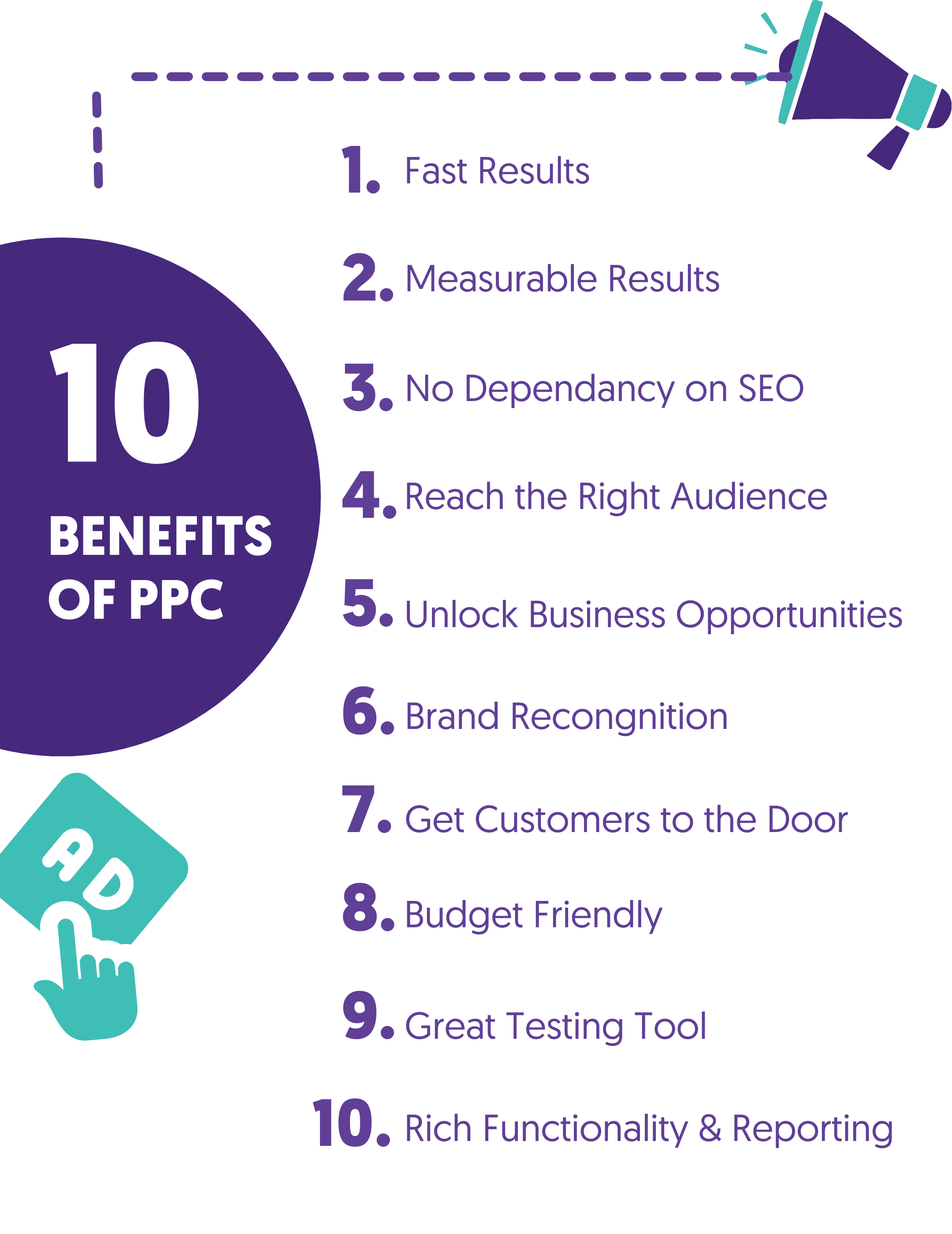
The core advantages our marketing experts see from PPC include the following:
Rapid results: SEO strategies are fantastic for long-term growth. Even the best SEO companies can’t promise instant results.
It can take months or years to rise to the top of the SERPs organically. However, optimized PPC ads appear on the top of the search results instantly (almost), driving new traffic and leads.
Opportunities to experiment: PPC tools like Google Ads allow companies to run split A/B tests with different ad variations, experiment with CTAs and copy, and determine which strategies drive the biggest return on investment.
Exceptional targeting: While you can target specific customers with carefully chosen keywords in SEO, PPC ads give you more specific targeting options.
You can focus on tailoring your ads to customers with specific behaviors or buying preferences. Plus, you can create retargeting ads to drive lost customers back to your site.
Fewer algorithm issues: Google’s algorithm is constantly changing, with new ranking factors affecting campaign performance all the time.
However, these evolutions don’t have an impact on your PPC campaigns. You can continue to rank regardless of factors like domain authority, and you don’t have to update your strategy as often.
Brand recognition: PPC is one of the best tools around for generating brand awareness and recognition.
With the right campaigns, you can position your business in front of customers during every stage of their purchasing journey and boost your credibility and authority as a leader in your industry.
Reduced costs: The amount you spend on PPC ads will vary depending on a number of factors, but PPC does give you more control over how you manage your budget.
You can choose exactly how much you want to pay for each click, and because you can measure everything consistently, you can ensure your ads are paying off.
Plays well with other marketing strategies: Moreover, while PPC can be used as a standalone tactic, it is recommended to use it in conjunction with other advertising campaigns.
Using SEO and PPC together can significantly strengthen your online presence. Plus, the data you get from PPC ads can help you to create more compelling, targeted SEO content.
Learn More about the importance of PPC marketing in the following guide.
- Benefits of PPC for Small Businesses
PPC Marketing in an AI World
Google recently announced significant changes to how search engine result pages would be structured for modern searchers.
The company now uses AI technology to help customers find the information they want faster than ever.
With the arrival of the new Search Generative Experience, browsers will see more AI-recommended content at the top of the SERPS.
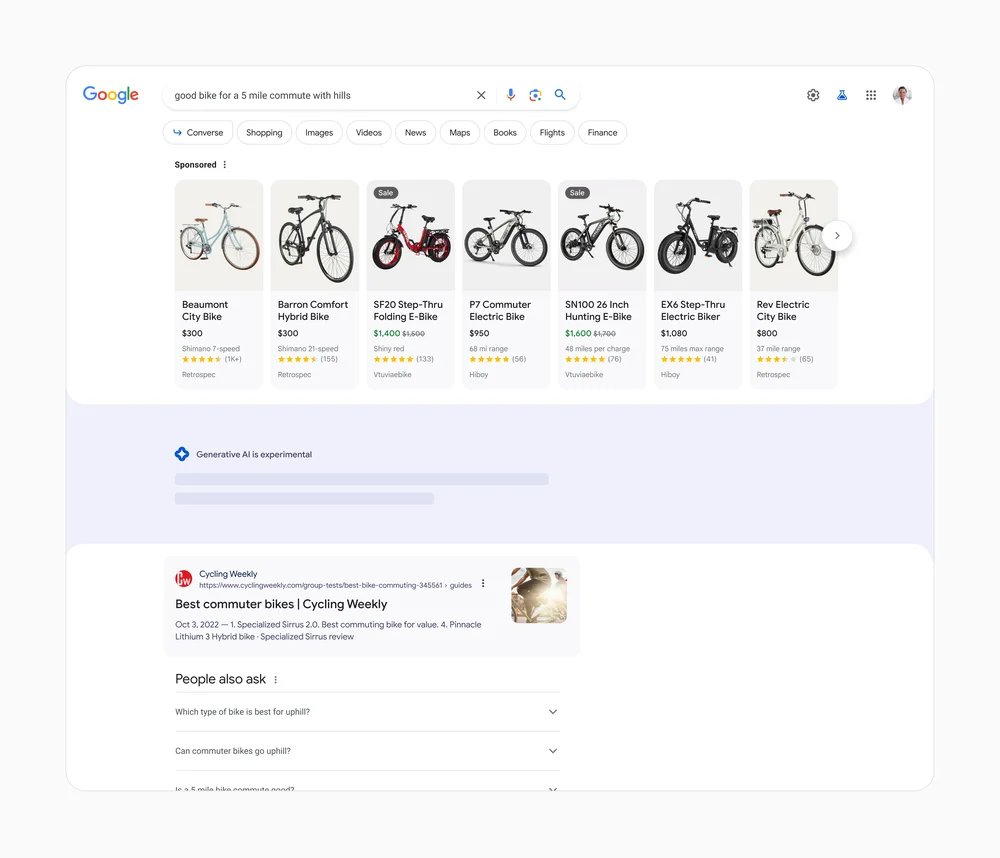
This means we’ll likely see more paid advertising placements at the top of the pages while organic results and content are pushed further down.
While the change is unlikely to eradicate the need for SEO and organic content entirely, it does mean companies will struggle to get targeted traffic with organic campaigns alone.
In the age of AI-powered search engines, businesses will rely more on paid ads to ensure they can capture and convert their ideal audience.
How Does PPC Marketing Work?
PPC Marketing can seem complex on the surface, but it is relatively straightforward.
Here is a quick overview of how PPC marketing works.
- PPC Marketers create campaigns using a PPC platform, such as Google Ads or Facebook ads.
- Depending on the platform, there are various settings you can configure, like choosing specific audiences, specifying campaign goals, creating different kinds of ads, choosing where you want your ads to appear, and more.
- Before launching a campaign, you can set a specific budget to determine how much money you want to spend on a campaign.
Whenever a potential lead clicks on one of the ads you’ve created, you’ll pay a fee based on several factors determined by the advertising platform.
This means you only pay for valuable activity driven toward your site.
Where do PPC Ads appear?
PPC ads can appear in different environments, depending on your chosen campaigns.
For instance, text ads created with Google Ads typically appear at the top of the search engine results on desktop and mobile devices.

Shopping ads appear in carousels at the top of the search pages, showcasing images, prices, merchant names, reviews, and offers.

Local ads targeted at a specific geographic audience can appear either on the search engine results pages or within the “Google Maps” section of the Google search results.
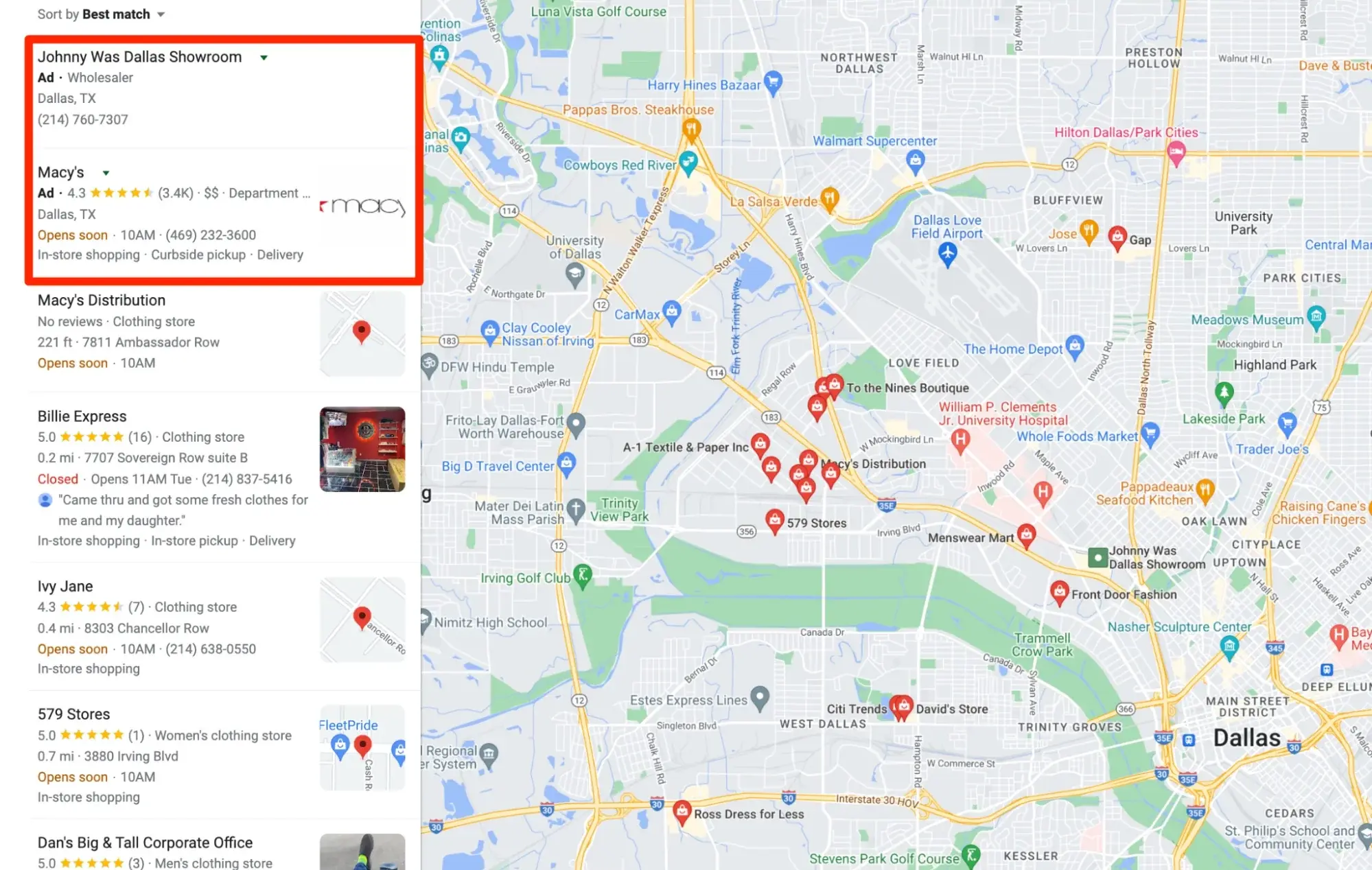
The exact positioning of your ad will vary depending on numerous factors. Google, for instance, analyzes your keyword bid, the relevance of your ad, and the past performance of your PPC campaigns to choose your positioning.
How to Learn PPC Marketing?
Although PPC can be a reasonably easy-to-master marketing tactic, it has a number of challenges.
This is one of the reasons why many PPC marketers invest in constantly expanding their education, with:
Free PPC guides and whitepapers: Companies like the Search Engine Journal and many others produce free downloadable guides with tips and tricks on PPC marketing. These learning assets are ideal for beginners looking to update their knowledge quickly.
Free Google Ads training courses: Many leading marketing organizations also offer free training courses, which provide basic insights into PPC and SEM strategies. A good example is the Google Ads training courses that Google Skillshop and Facebook Blueprint Certifications offer.
Paid courses and workshops: Offering a more in-depth guide to the world of PPC, paid digital marketing courses tend to provide more comprehensive guidance, downloadable resources, and even the opportunity to earn certificates to showcase on your resume.
PPC blogs, articles, and podcasts: For everyday learning, marketers can follow popular PPC blogs, check out podcasts, and read up on insights from industry thought leaders shared across social media. These tools are often useful for catching up on PPC news.
Branded training courses: Marketers specifically interested in learning how to use Facebook Ads, Bing ads, or Google Ads can also access dedicated branded courses, training programs, and workshops from these brands.
Read the following guides for more training options and courses to learn PPC and get certified.
- Best PPC Certifications
- How to Become a PPC Expert
- Google Ads Certifications
How to Create a PPC Strategy?
There are many nuanced stages involved in building a truly effective PPC campaign. To increase your results, here are some of the core steps involved in developing your own PPC strategy.
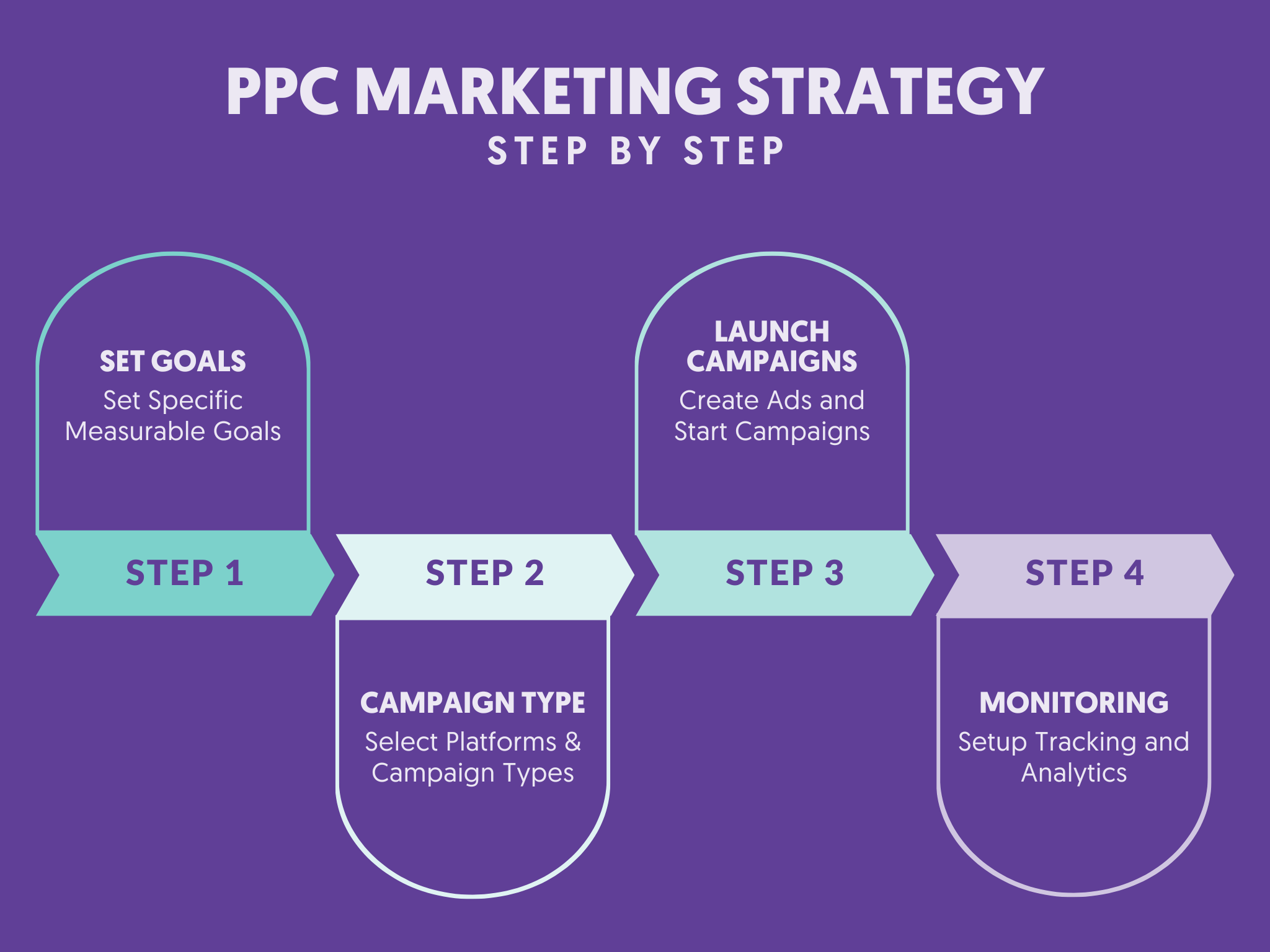
Step 1: Set Specific, Measurable Goals
PPC advertising works best when the ads you create are targeted and strategic.
With this in mind, before you dive into any PPC campaigns, take a moment to consider your overall business and marketing goals.
Think about what you want to accomplish with PPC marketing, and determine who you want to target, the theme of your campaigns, and how you will measure success.
Based on these insights, you can set specific goals for your PPC strategy within your ad platform.
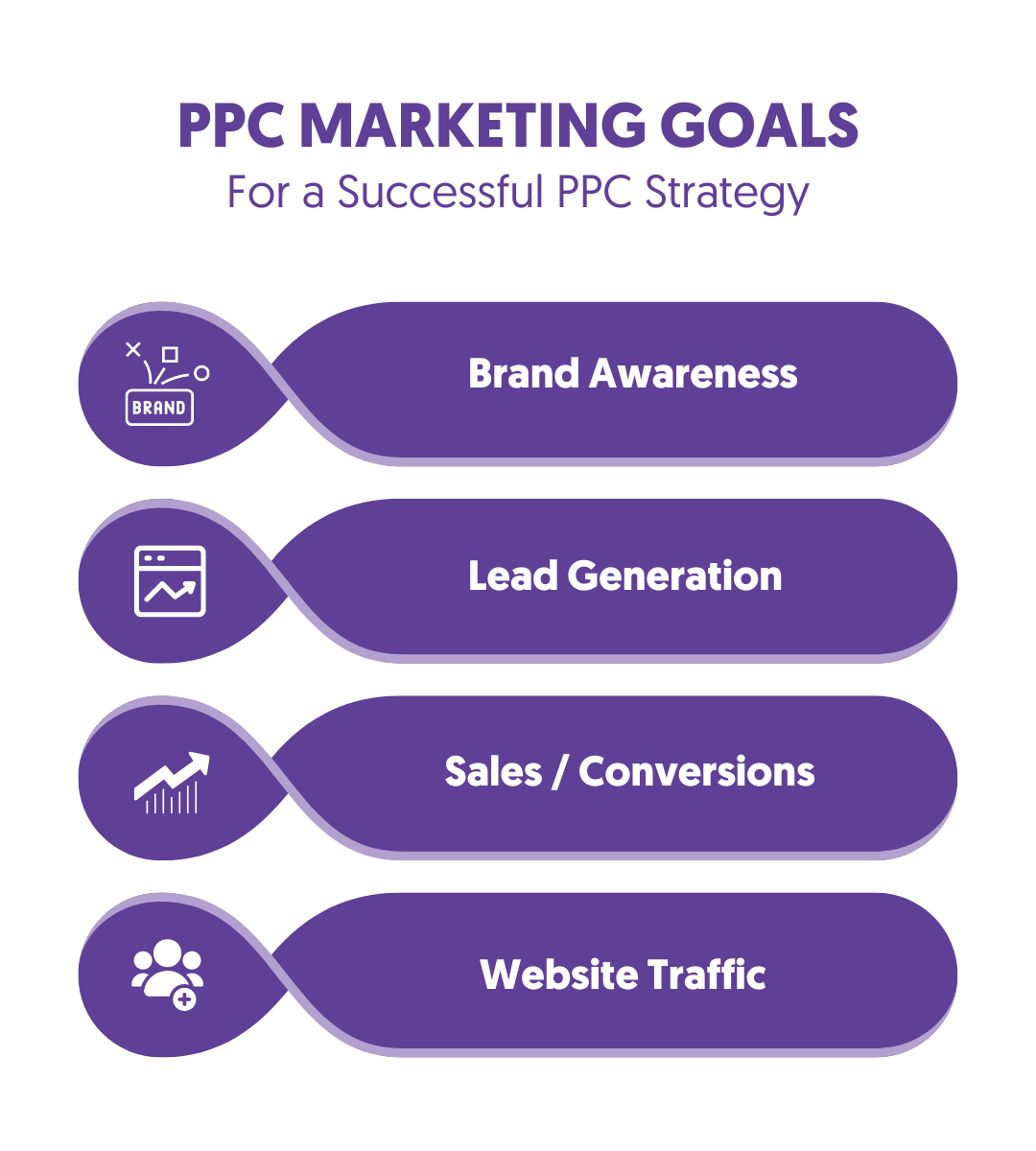
Common goal options include:
- Brand awareness: If you want to drive attention to your company, and transform your business into a household name, focusing on brand awareness is helpful. You can measure the growing brand recognition by looking at traffic numbers and social engagement.
- Lead generation: One of the most common campaign goals for PPC strategies, lead generation, focuses on actively adding new prospects to your sales funnel. You can use tools like Google Analytics and tracking pixels to determine where your most valuable leads come from and which strategies drive conversions.
- Sales or offer promotions: If you’re trying to generate sales or you’re drawing attention to a limited-time offer, you can focus on this with your PPC campaigns.
- Site traffic: If your website is packed with high-quality content designed to convert customers and move them through the purchasing funnel, you may focus on targeting site traffic. This means concentrating on capturing leads at the top of the buyer funnel and introducing them to your business and services or products.
Step 2: Select your Campaign Type
The exact types of campaigns you can run for each PPC strategy will differ depending on your chosen platforms.
Experimenting with different campaign types can help you to optimize your PPC budget. Some of the most common options include:
Search ads: Easily the most common type of PPC ad, search ads are text-based ads that appear at the top of the SERPS. They’re ideal for building brand awareness, driving traffic to your website, and generating leads.
Display ads: Typically image-based ads, display ads appear on websites participating in different advertising platforms like Google Adsense. They’re a popular choice for showcasing deals, offers, and sales.
Social ads: Social ads appear on social media channels like Twitter, LinkedIn, Facebook, and Instagram. They look similar to standard social media posts and are often available in various formats, from image and video posts to carousels.
Remarketing ads: Designed to draw customers back to your website after they leave, remarketing ads connect with people who have engaged with your company before. They’re great for nurturing leads and reducing cart abandonment.
Google shopping ads: Ideal for e-commerce sites, Google shopping ads allow you to showcase your product in a carousel at the top of the search engines, along with product descriptions, pricing, images, and even customer ratings.
Step 3: Find your Keywords (for search ads)
Keywords are the lifeblood of a Google Ads search campaign.
This is how Google Ads knows when to display your ads to your customers during their search journey. Crucially, the keywords you choose need to be specific and relevant.
For instance, if you’re going to be advertising your SEO marketing agency online, you shouldn’t just target the term “SEO”.
Selecting specific keywords based on the theme of your ad, the target audience you want to reach, and their intent is important.
If you advertise a special price for your SEO service package, you might target terms like “SEO advertising pricing” or “SEO services”.
You can also choose specific terms based on the location of your target audience, such as “New York SEO agency”.
Keep in mind that you’re not stuck with the keywords you choose at the beginning of your campaign. You can monitor the performance of your terms over time, increase your bid for certain phrases, and add new terms into the mix too.
If you need some keyword inspiration, try experimenting with keyword tools like Ahrefs, Google Trends, AnswerThePublic, and SEMRush.
Step 4: Create your Campaigns
The next step is creating your ad content. The media you include, such as images, videos, and text, will depend on your selected campaign type.
Creating the best campaigns takes time and experimentation, but you can boost your chances of success by:
Optimizing your copy: Make sure your URL, headline, and the short description you use in your ads speak directly to your target audience.
Include keywords, highlight the benefits of your offering, and use an actionable CTA to let people know what to do next, such as “click here”.
Creating landing pages: Creating powerful landing pages connected to your PPC campaigns can improve your chances of converting visitors to your websites into customers.
Your landing pages should mirror your search ad and feature a clean design and layout. Use powerful, emotional copy, and remember to implement your keywords.
Targeting the right audience: Many PPC solutions like Google Ads allow you to focus on a very specific audience.
You can utilize tools like in-market audiences and dynamic audiences to improve your chances of reaching people with specific demographics and behaviors.
Step 5: Set up Tracking and Analytics
Perhaps the most important step in ensuring your PPC campaign is successful is ensuring you have a way to track and monitor your results.
PPC campaigns aren’t a set-it-and-forget-it marketing strategy. They need to be updated and optimized over time.
The easiest way to monitor the results of your campaigns is with Google Analytics. This free tool provides insights into the performance of your website and how customers interact with your content.
Besides Google Analytics, you should use the reporting features of your chosen PPC platform to monitor key metrics like:
- Clicks: The total number of clicks received on an ad.
- CPC (Cost per Click): The price you pay for every ad click.
- CTR (Clickthrough rate): The percentage of ad views that result in clicks.
- Impressions: The number of times an ad is viewed.
- Ad spend: The overall amount you spend on your ads.
- Cost per conversion: The price you pay to generate a lead.
- Conversion rate: The percentage of people who convert after clicking on an ad.
Best PPC Advertising Platforms
One of the most important steps in developing an effective PPC campaign is choosing the right platform for your specific needs. You can choose to focus on a single platform or divide your attention between popular options like:
Google Ads
By far the most popular platform for PPC, Google Ads holds around 87% of the market share for PPC advertising.
With Google Ads, you can run various types of ads across the Google Search result pages, as well as the shopping network, Google Maps, and the Google Display Network.
If you want to capture a wide range of customers with various campaigns, Google Ads is an excellent choice.
You can use the expert guides below to learn more about Google Ads.
- How to Become a Google Ads Specialist (Complete Guide for Beginners)
- Google Search Ads for Beginners (Starter’s Guide)
- 10 Best Google Ads Courses for Beginners (Free & Paid)
- How do Google Ads work? (Easy Guide for Beginners)
Bing Ads (Microsoft Advertising)
Microsoft Advertising is a comprehensive marketing platform owned by Microsoft. The platform displays ads through Bing, Yahoo, Windows, Cortana, and other environments.
Although it has less reach than Google Ads, Microsoft Advertising can be ideal for lowering your cost-per-click and reaching new customers.
Microsoft also allows you to target people based on LinkedIn profiles, which could make it an ideal choice for companies in the B2B landscape.
This could be the ideal platform for you if you’re trying to target business leaders, marketing managers, and other professionals.
Other Ad Networks
There are also various other networks where you can invest in PPC campaigns. For instance, if you’re running an e-commerce store and selling your products on Amazon, you can run PPC campaigns within Amazon to boost your chances of appearing on Amazon’s search results pages.
You can also run PPC ads directly on some social media platforms, such as Facebook and Instagram, as well as LinkedIn and TikTok. Experimenting with different ad networks could be an excellent way to connect with a more targeted audience.
Conclusion
PPC ads aren’t exactly a new concept. However, the importance of PPC marketing has increased drastically in the last few months. Today, PPC is perhaps the best way to connect with your target audience and generate rapid results from your advertising campaigns.
In the world of generative AI and AI-driven search, learning how to use PPC to your advantage could help you to boost the ROI of your marketing campaigns and bring new revenue to your company.








